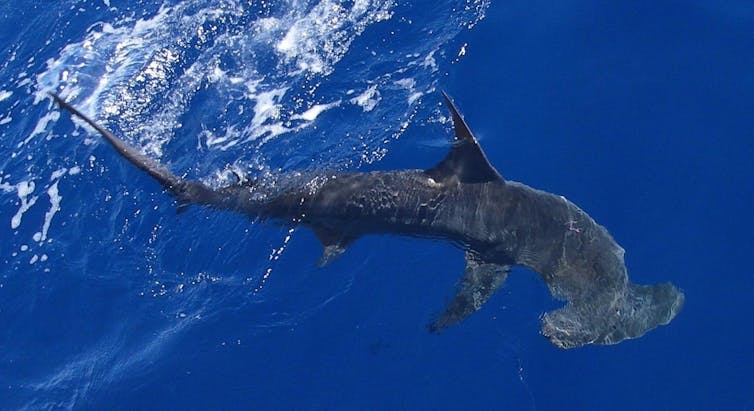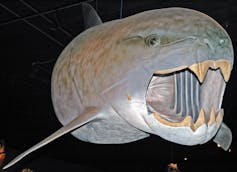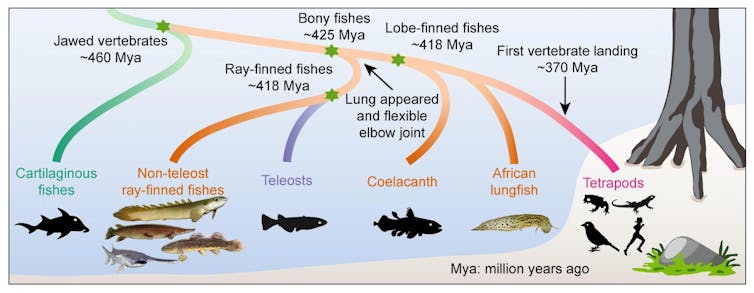Why do humans have bones instead of cartilage like sharks?

Michael Heithaus, Florida International University

Curious Kids is a series for children of all ages. If you have a question you’d like an expert to answer, send it to curiouskidsus@theconversation.com.
Why do humans have bones instead of cartilage like sharks? – Natalya N., age 12, Aliso Viejo, California
First, let’s talk about the difference between bone and cartilage. They both are materials that can make up a skeleton, but they are quite different.
Bone doesn’t bend. It is very strong, but it’s also brittle and can break with too much pressure. Cartilage is strong, but it is squishier and can bend.
Human skeletons are made of bone, but we also have cartilage in our ears and noses and as padding in our joints. In fact, much of our skeleton is cartilage when we are babies, but as we grow it is replaced by bone.
Cartilage is too rubbery to support the weight of a person. If our skeletons were made of cartilage, we would collapse under the weight of gravity. Our bodies need the unbending strength of bone to support their weight on land.
In the water, however, sharks’ cartilaginous skeletons have helped them survive and thrive. Since cartilage is lighter than bone, sharks don’t have to work as hard to swim. This is very important, because they sink if they stop swimming. If they had heavier skeletons, they would have to work harder and spend more energy just to keep moving.
Cartilage is strong but flexible, so it helps sharks be fast and maneuverable swimmers. That helps them catch prey and avoid predators. And sharks do have predators. Many large sharks, like great hammerheads, love to eat smaller sharks. And orcas, or killer whales, will eat large white sharks. Some sharks, like lemon sharks, will even eat smaller members of their own species.
The benefits of bone
There are currently around 1,000 species of fish with cartilage for skeletons, and more than 28,000 fish species with mostly bony skeletons. Since bone doesn’t bend and can be very strong, it can help muscles work better by providing unbending support. So having bones opens up more possibilities for how a body is put together and how it can be moved through the water.
For example, there are lots of different shapes of bony fish. Many of them use the pectoral fins on their sides to move around, instead of propelling themselves with their tails like sharks. That enables them to move forward and backward, which is very handy for moving in and out of tight spots, like nooks in a coral reef.
 A model of a fossil placoderm skull that was found in what is now northeast Ohio.James St. John/Flickr, CC BY
A model of a fossil placoderm skull that was found in what is now northeast Ohio.James St. John/Flickr, CC BYPlacoderms had amazing bony plates that protected their heads and parts of their bodies, but the rest of their skeletons were made of cartilage. That’s one reason we find fossils of their head and jaw plates but not the rest of their skeleton. Cartilage rarely fossilizes.
Our fishy family tree
Placoderms are probably the ancestors of two major groups of fish – modern sharks and rays, with skeletons made of cartilage, and bony fish. Both groups have survived for hundreds of millions of years. But it was bony fish that gave rise to amphibians – the first creatures that left the sea and developed limbs and lungs that enabled them to live on land.

Those amphibians with their bony skeletons gave rise to reptiles, and from reptiles came birds and mammals – eventually including humans. That means we can trace our bones all the way back to ancient fish. Today there are about 60,000 species on Earth with skeletons of bone swimming, living on land or flying through the air.
Hello, curious kids! Do you have a question you’d like an expert to answer? Ask an adult to send your question to CuriousKidsUS@theconversation.com. Please tell us your name, age and the city where you live.
And since curiosity has no age limit – adults, let us know what you’re wondering, too. We won’t be able to answer every question, but we will do our best.![]()
Michael Heithaus, Executive Dean of the College of Arts, Sciences & Education and Professor of Biological Sciences, Florida International University
This article is republished from The Conversation under a Creative Commons license. Read the original article.
